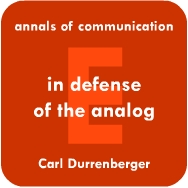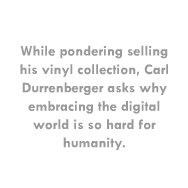

I have a record collection of 500-some-odd titles that I've been assembling since my Sophomore year in high school. That was 1991 and I vividly remember staying up late into the night trying to retrieve the music locked within those vinyl grooves. I remember attending garage sales, where I would walk away with armfuls of records gotten for next to nothing. And I remember frequenting Half-Price Books and the myriad used record shops in Austin, kneeling down on the floor to browse the racks of LP's, breathing in the faint musty smell they exuded. It was a wonderful ride that lasted through college and graduate school, two turntables, and several grueling moves, three of them cross-country.
But I don't listen to my records much anymore and am beginning to think about selling them, along with my exquisite Linn turntable and elaborate record-cleaning apparatus, on e-Bay before my next move. To be sure, I still find much to like and treasure about them: the sound is different from compact discs in a way that I find preferable; the album jackets contain artwork that you can actually see and liner notes with real depth; and the ritual itself of playing the things can sometimes be great fun.
Beyond those somewhat tangible assets, I suppose my record collection serves as a personal monument to the departed analog era, reminding me to respect a time before music was crunched into digits and cell phones roamed from state-to-state in people's backpacks. It is an avocation that extends beyond pure nostalgia into ideological notions of the analog nature of humanity. It is a metaphysical question as much as it is a scientific one, for reality does not exist solely in the physical domain but in the mind as thoughts, emotions, idealizations, and rationalizations, all of which are difficult to objectively observe for obvious self-referential reasons.
So, I sit before my shelves of records asking what this metaphysical attraction to vinyl is and whether it is valid enough to justify the great pains involved with schlepping my little analog monument across town to a new apartment. Most of my friends just don't understand. They think I'm a fool, or worse, some high-minded pseudo-intellectual trying to rationalize cheap romantic yearnings. "Just sell 'em and convert to CD's," they say. But, I'm putting off the online auction for a time while I ruminate on what it means to be analog; what it means to be digital.
It helps that I'm not the only one out there trying to hang on to artifacts of the analog world for symbolic comfort; there's a whole slew of writers expressing their wariness of the new digital order. Just last week, opening the Times and the New Yorker provided two examples.
In the Times, it was an article describing the appeal of the Fender Rhodes electric piano to today's artist who has access to cheaper, more sophisticated digital keyboards. "With a Rhodes, you're dealing with metal and wood, not computer chips," testified pianist Jacky Terrasson on why he plays 20 percent of all his live sets with that relic of the analog era.
Well, yes, Jacky, but computer chips are made up of silicon
and lead solder, so the comparison of materials is a bit misguided. What
should be compared is the functionality of the things made out of the
materials, not the "wood" and "metal" themselves;
that is where the divergence between analog and digital technology lies
and what the New Yorker piece from that same week attempts to explore:
"Professor Malik Solanka listened to the sour of Eleanor's voice,
and with some distaste imagined its being broken into little parcels of
digitized information, her low, lovely voice first consumed and then regurgitated
by a mainframe computer probably located in someplace like Hyderabad-Deccan.
What is the digital equivalent of lovely? he wondered. What are the digits
that encode beauty, number-fingers that enclose, transform, decode, and
somehow, in the process, fail to trap or choke to soul of it? Not because
of the technology but in spite of it, beauty, that ghost, that treasure,
passes undiminished through the new machines."
In the above excerpt from "Summer of Solanka" by Salman Rushdie (The New Yorker, July 16, 2001), the Professor is remarking on the implausibility of carrying an emotional signal - his wife's impassioned speech - over a rational medium - a string of digits processed by computers. And there lies the fundamental crux of mankind's uneasiness with digital technologies: how to reconcile the logic of the computer with the mysticism of our being.
In order to explore this dilemma, it may be helpful to compare the difference between a digital and an analog phone call to find divergences in how the two technologies handle the caller's message.
In an analog phone call, the caller first speaks into the receiver mouthpiece, transmitting the forces of vocal air pressure to a small membrane housed inside. Because the membrane is magnetized, its vibrations push and pull electrons that reside in a surrounding matrix of wires, creating an electrical signal that can be sent through telephone lines across long distances. At the other end, where the caller's friend sits patiently listening, a reciprocal process converts the electrical signal back into an air pressure wave which is heard through the ear piece.
As illustrated in the preceding example, "analog" technologies are those methods of communication wherein an unbroken linkage of direct, physical analogies is employed to transport a signal across time and space. There is no active decision-making that intervenes between the two people in virtual contact. Only the laws of physics govern how the analogies operate - perhaps a kind of implicit decision-making outside of the realm of human understanding - allowing the possibility of some other force playing an invisible hand in making them work. This is from where some of the mystique of analog derives; it is impossible to rule out the role of the spiritual in any passive system because you haven't explicitly engineered it out.
With a digital phone call, the same process as described above occurs, but at some intermediate step, the original electrical fluctuations are converted to a stream of digits that can be routed through computer-controlled switchers and beamed through optical cables as pulses of light. In this transformation, active decisions are made, thousands of them a second, in how to parse the continuous current fluctuations into discrete chunks of data. This is a process called sampling.
Sampling imposes an explicit human logic on the signal because the decisions that are used to make it work are made by a programmable logic microchip engineered by a team of engineers. Rationality casts its shadow over the event as the chain of direct physical analogies connecting the original event to the electrical signal is broken and a non-analogy is spliced into the sequence.
We have also inserted an active process into a series of passive ones when we sample a signal. The physical linkage of analogies that comprises an analog system is passive because it adds nothing to the original event except randomness, or noise. It's akin to imaging a Rube-Goldberg machine with lots of play in its parts: errors of omission may occur, but errors of commission are impossible. Sampling, however, fundamentally changes the signal as each decision made by the microprocessor converts the flux of electrons into a sequence of numerical snapshots. It is a transformation of kind, not degree. A continuous signal has been made discrete in the time and descriptive dimensions. In the former domain, this happens by parsing the continuum of time into a snapshot representation, much as a movie captures smooth action as a sequence of rapid-fire still-frames. In the descriptive dimension, it happens when a numerical value is assigned to each snapshot, reducing each "picture" of the event to a number. In a sense, then, digital technology is interpretative, whereas analog is purely transitive.
For those who have fallen in love with the ideal domain of the mind, analog technology holds many attractions as well. It is a way of idealizing physicality as a smooth, continuous place amenable to the mathematics of calculus and solid geometry. In the analog world, media are not composed of discrete building blocks (molecules), but considered to be made of some sort of continuos "ideal" matter. In this ideal domain, then, vinyl records and magnetic tape have the possibility for infinite storage resolution, a beautiful picture for the mind to contemplate. Furthermore, the assumption of physical continuity extends into the notion of continuous idea space: that intelligence extends beyond digital neural firings into a realm allowing for infinitely subtle gradations of thought and capable of understanding the notion of infinity. And the notion of infinity is an oft-cited foundation of spirituality.
Digital, in contrast, is a rather cynical way of looking at the universe. It is a technology founded on the platform of a discrete world, resigned to its imperfections. Digital realizes that all signals must be carried on non-ideal media composed of tiny building-blocks and that there is therefore really no such thing as a perfect chain of analogies connecting two events. Instead of leaving the concomitant error up to the laws of physics, it co-opts error management into the human domain of decision-making to obtain control over the imperfections. From a completely rational viewpoint, this is an improvement over the old analog communication methods. Indeed, by all technical measures, the new digital technologies have granted us the ability to send and store much clearer and more accurate signals than ever before.
But from the metaphysical viewpoint, this transfer of error from the mystical forces of nature into the rigorous annals of digital logic is tantamount to reducing human communications to the purely rational level. And I don't like it at all.
I would like to leave some aspects of my contact with the rest of humanity up for grabs in the mystical domain, to allow for chance happenings and spiritual interventions. I like the notion of the analog, of an unbroken chain of transitive analogies connecting my listening of a Glenn Gould LP to the events that transpired in Columbia's 30th Street recording studio in New York forty years ago. I like analog's insistence on working within an ideal world wherein time and space and all matter are perfect and continuous.
And I will keep my record player, the vinyl-cleaning machine, the wall-to-wall shelving, and the expensive habit of replacing the stylus annually. When it comes time for me to move from the outer fringes of so-Cal suburbia into the heart of the city, I'll have to get my friends to help lug all that gear to a new apartment somewhere on the third story of some elevator-less building. They'll bitch and give me hell and make me feel like a nostalgic fool. And after they've left, I'll light a candle, put on Ray Charles's The Genius After Hours, pour a glass of good red wine, and toast my own private analog monument.
San Diego
August 2001